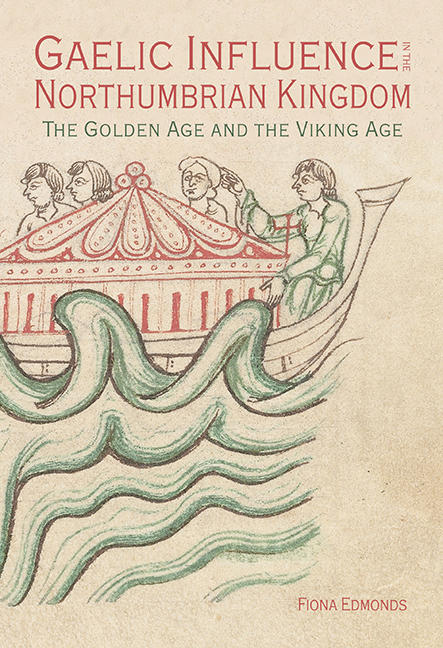Book contents
- Frontmatter
- Contents
- List of Illustrations
- Acknowledgements
- List of Abbreviations
- Preface: An Eventful Voyage
- 1 Concepts and Historiography of the Northumbrian and Gaelic Worlds: Medieval to Modern
- 2 Exiles and Emperors: Gaelic-Northumbrian Political Relations in the Golden Age
- 3 Fragmentation and Opportunity: From the Eighth Century to the Viking Age
- 4 Pathways through the Past: Routes between the Gaelic World and the Northumbrian Kingdom
- 5 A Golden Age of Ecclesiastical Contacts
- 6 Saints and Seaways in the Viking Age
- 7 Medieval Multilingualism: Gaelic Linguistic Influence in the Northumbrian Kingdom
- 8 Movement and Material Culture in the Northumbrian and Gaelic Worlds
- Conclusion: Individuals and Influences
- Bibliography
- Index
- STUDIES IN CELTIC HISTORY
Preface: An Eventful Voyage
Published online by Cambridge University Press: 28 February 2020
- Frontmatter
- Contents
- List of Illustrations
- Acknowledgements
- List of Abbreviations
- Preface: An Eventful Voyage
- 1 Concepts and Historiography of the Northumbrian and Gaelic Worlds: Medieval to Modern
- 2 Exiles and Emperors: Gaelic-Northumbrian Political Relations in the Golden Age
- 3 Fragmentation and Opportunity: From the Eighth Century to the Viking Age
- 4 Pathways through the Past: Routes between the Gaelic World and the Northumbrian Kingdom
- 5 A Golden Age of Ecclesiastical Contacts
- 6 Saints and Seaways in the Viking Age
- 7 Medieval Multilingualism: Gaelic Linguistic Influence in the Northumbrian Kingdom
- 8 Movement and Material Culture in the Northumbrian and Gaelic Worlds
- Conclusion: Individuals and Influences
- Bibliography
- Index
- STUDIES IN CELTIC HISTORY
Summary
A fierce sea lashes a boat that is transporting a very precious cargo. A group of people huddle by the shore; they watch the scene with dismay and pray for a safe outcome. The helmsman vainly tries to steer, but this is not an ordinary storm. Three waves miraculously turn into blood as they break over the side of the vessel, and the voyage is abandoned.
This dramatic scene is a depiction of the attempt to send the relics of St Cuthbert to Ireland. It belongs to a series of miniature pictures that accompanied accounts of the saint's life and miracles in a manuscript from Anglo-Norman Durham. The incident took place in the 870s, a decade that straddled the eras covered in this book: the Golden Age of the seventh and eighth centuries, and the Viking Age. The episode encapsulates the enduring nature of Gaelic influence in the Northumbrian kingdom, for Cuthbert was a renowned Northumbrian saint, and the attempted voyage took him towards Ireland, a key part of the Gaelic cultural world.
The Northumbrian kingdom was the most northerly of the Anglo-Saxon polities. In its heyday the kingdom stretched across much of modern-day northern England and southern Scotland, from the River Mersey to Ayrshire and from the Humber Estuary to the Firth of Forth. This extensive area includes landscapes that are prized in the modern day for their untamed appearance: swathes of heather moorland on the Pennines and the Border Hills, and sharp peaks formed from volcanic rock in the Lake District. Yet the kingdom also encompassed areas rich in agricultural potential, especially for cattle-rearing. These areas sustained a wealthy nobility, important churches and incipient urban centres. The Northumbrian elites travelled widely, forged links with other kingdoms, and developed an appetite for exotic goods. At the northern and southern ends of the kingdom, the great coastal indentations of the Humber and the Forth could be traversed to reach Anglo-Saxon Mercia and the Picts, respectively. Two long coastlines opened the kingdom up further to external influences. The western coast is lapped by the Irish Sea and the North Channel, over which sailors voyaged to the Gaelic world: Ireland, western Scotland and the Isle of Man.
- Type
- Chapter
- Information
- Gaelic Influence in the Northumbrian KingdomThe Golden Age and the Viking Age, pp. xv - xviiiPublisher: Boydell & BrewerPrint publication year: 2020

